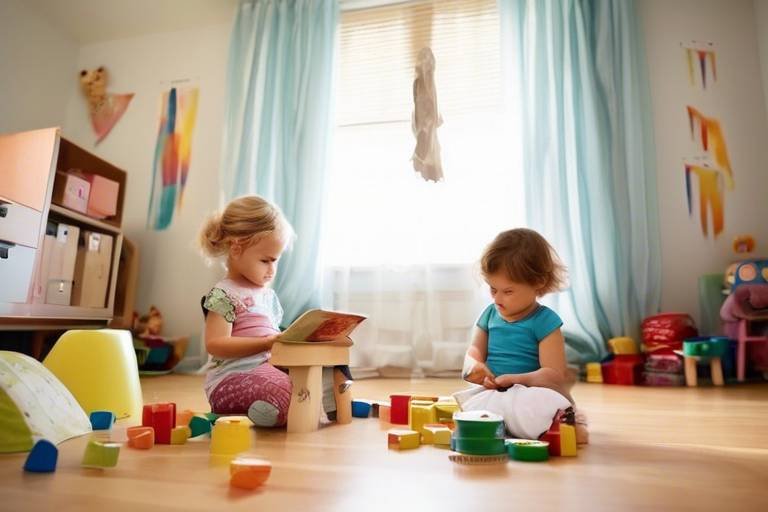Creating a Home Safety Plan for Families
In today's unpredictable world, the safety of our families is a top priority. Creating a comprehensive home safety plan is not just a good idea; it’s essential. Think of it as your family's insurance policy against the unexpected. Just like you wouldn't leave your home unprotected, you shouldn't leave your family unprepared for emergencies. This article outlines essential steps to develop a comprehensive home safety plan, ensuring families are prepared for emergencies and can protect their loved ones effectively.
Identifying potential hazards within the home is crucial for creating a safety plan. Start by walking through your home with a critical eye. Look for common risks such as:
- Loose rugs that could cause falls
- Electrical cords that could pose tripping hazards
- Heavy furniture that could tip over
Evaluate your living environment for safety concerns by considering the age of your home and its structure. Are there any outdated electrical systems? Is the plumbing in good condition? These factors can significantly impact your family's safety. Don’t forget to check outdoor areas as well; ensure that walkways are clear and that any potential hazards like sharp tools or chemicals are safely stored away.
A well-prepared emergency contact list is vital. Imagine a scenario where every second counts. In such moments, having a quick reference can make all the difference. Include the following on your list:
- Family members' contact information
- Neighbors or close friends
- Your family doctor and local hospitals
- Emergency services (fire, police, ambulance)
Make sure this list is accessible to all family members. Consider placing it on the fridge, in your family’s phones, and even in your children's backpacks. Regularly update the list to ensure that it remains current and useful.
Implementing fire safety protocols can save lives. A fire can spread in mere minutes, so preparation is key. Start by installing smoke detectors on every level of your home and check them monthly. Next, develop a fire escape plan that includes at least two exits from each room. Practice this plan regularly, so everyone knows what to do in case of an emergency. Remember, it's not just about having a plan; it's about knowing how to execute it efficiently.
Understanding the types of natural disasters that may affect your area is important. Whether it’s earthquakes, floods, or severe weather events, your family should know how to respond. Create a disaster kit that includes essentials like water, non-perishable food, flashlights, and a first aid kit. Additionally, ensure everyone knows the safest spots in your home during an earthquake or where to go in case of a flood. Knowledge is power, and being informed can significantly reduce panic during a crisis.
Equipping family members with first aid knowledge is essential for handling emergencies. Consider enrolling in a first aid course together as a family. Not only will you learn valuable skills, but you’ll also bond over the experience. Resources are available online, or you can find local classes offered by organizations like the Red Cross. Knowing how to perform CPR or treat minor injuries can be lifesaving, and it empowers everyone to act confidently in emergencies.
Keeping children safe requires specific measures. Childproofing your home is the first step. This means securing heavy furniture to walls, using safety gates, and covering electrical outlets. But it doesn’t stop there; teaching kids about safety protocols is equally important. Explain to them what to do in emergencies, such as how to call 911 or where to meet outside if they need to evacuate. Remember, kids are curious, so making safety fun can help them remember these important lessons.
Pets are part of the family and need protection too. When creating a safety plan, don’t forget about your furry friends. Have a pet emergency kit that includes food, water, and any necessary medications. Familiarize yourself with pet-friendly shelters in case you need to evacuate. Just like you, your pets can experience stress during emergencies, so having a plan will help keep them calm and safe.
Effective communication during emergencies is key. Establish a family communication plan that outlines how everyone will stay in touch if you’re separated. This could include designating a meeting place or using a specific group chat. Ensure that everyone knows how to use their phones and any necessary apps for communication. In crises, clear communication can help reduce anxiety and keep everyone informed.
Regularly reviewing and practicing your home safety plan is essential for preparedness. Life changes, and so do your needs. Make it a habit to revisit your plan at least twice a year. Conduct drills to ensure everyone remembers their roles, and update the plan as necessary. The more familiar everyone is with the plan, the more confident they will feel during an actual emergency.
Q: How often should we review our home safety plan?
A: It's recommended to review your home safety plan at least twice a year or whenever there are significant changes in your family situation.
Q: What should be included in a disaster preparedness kit?
A: Your kit should include water, non-perishable food, a flashlight, a first aid kit, necessary medications, and important documents.
Q: How can I teach my children about safety?
A: Make safety fun by using games, role-playing scenarios, and discussing safety in everyday situations.

Assessing Home Risks
When it comes to creating a solid home safety plan, the first step is to get a good grip on the potential risks lurking within your four walls. Think of your home as a fortress; if you don't know where the weak spots are, how can you defend it? Start by walking through each room and considering what could go wrong. Is there a loose rug that might trip someone? Are the stairs well-lit? Do you have enough smoke detectors? These might seem like small details, but they can make a huge difference in an emergency.
To help you identify hazards, consider the following common risks:
- Fire Hazards: Check for overloaded electrical outlets, old wiring, and flammable materials stored near heat sources.
- Slips and Falls: Look for uneven surfaces, cluttered hallways, or loose carpets that could lead to accidents.
- Child Safety: Assess areas where children play, ensuring sharp objects, choking hazards, and toxic substances are out of reach.
- Natural Disasters: Depending on your location, consider risks like flooding, earthquakes, or hurricanes, and evaluate your home’s vulnerability.
Once you've identified these risks, it's time to evaluate your living environment. Take notes and prioritize which issues need immediate attention. For instance, if you notice that your smoke detectors are outdated, replace them right away. If you have children, childproofing measures should be at the top of your list. You might even want to create a simple risk assessment table to keep track of your findings:
| Hazard | Location | Action Needed |
|---|---|---|
| Loose Rug | Living Room | Secure with double-sided tape |
| Old Smoke Detector | Hallway | Replace with new unit |
| Cluttered Staircase | Stairs | Clear away items |
Don't forget to involve your family in this assessment process. Discuss the risks you've identified and ask them if they've noticed anything concerning. This not only helps everyone feel more invested in the safety plan but can also uncover hazards you might have missed. Remember, a safety plan isn't just a document; it's a living part of your family's daily life. The more aware everyone is, the better prepared you'll be when an emergency strikes.

Emergency Contact List
Creating a well-prepared is a crucial step in ensuring your family's safety. Imagine a situation where every second counts, and you need to reach out for help quickly. Having a list of essential contacts at your fingertips can make a world of difference. So, who should be on this list? Let's break it down!
Your emergency contact list should include not only immediate family members but also trusted friends, neighbors, and professionals who can assist in various situations. Here’s a simple guideline to help you create a comprehensive list:
- Immediate Family: Include all family members living in your home. Ensure everyone knows how to reach each other in case of separation.
- Extended Family: List relatives who live nearby and can be contacted if you need assistance.
- Friends and Neighbors: Choose reliable friends or neighbors who can help during emergencies, especially if you are away from home.
- Medical Contacts: Include your family doctor, local hospital, and poison control center. This information is vital in health emergencies.
- School Contacts: If you have children, make sure to have the contact information for their school and any after-school programs.
- Emergency Services: Always have the numbers for local police, fire department, and ambulance services readily available.
Once you’ve compiled this list, it’s essential to keep it accessible. Consider placing a printed version in a visible spot in your home, like on the refrigerator, and ensure that every family member knows where to find it. In addition, you might want to store a digital copy on your phone or in a cloud service for quick access. With the rise of technology, utilizing apps designed for emergency preparedness can also be beneficial.
It's not just about having the numbers; it’s about knowing how to use them effectively. Have a family discussion about the importance of this list. Make sure everyone understands who to contact for different emergencies. This conversation can serve as a valuable teaching moment, reinforcing the idea that being prepared is a shared responsibility.
In conclusion, an emergency contact list is more than just a piece of paper; it’s a lifeline. By taking the time to create and maintain this list, you are equipping your family with the tools they need to respond swiftly and effectively in a crisis. Remember, preparation today can lead to peace of mind tomorrow!
Q: How often should I update my emergency contact list?
A: It's a good practice to review and update your emergency contact list at least once a year or whenever there are significant changes in your family dynamics, such as moving or changes in contact information.
Q: Should I include contacts from outside my area?
A: Yes! Including a few contacts from outside your local area can be beneficial, especially if local communication lines are down during a disaster.
Q: How can I ensure my children know how to use this list?
A: Teach your children how to use the list by role-playing different emergency scenarios. This practice will help them feel more confident in reaching out for help when needed.

Fire Safety Measures
When it comes to keeping your family safe, are absolutely essential. Imagine waking up in the middle of the night to the smell of smoke or the sound of crackling flames. It’s a terrifying thought, but being prepared can make all the difference. First and foremost, you should ensure that your home is equipped with smoke detectors. These devices can be lifesavers, alerting you to danger before it becomes overwhelming. Make it a habit to check these alarms monthly and replace the batteries at least once a year. If you have a smoke detector that’s over ten years old, it’s time to replace it entirely.
Another critical aspect of fire safety is having a well-thought-out fire escape plan. This plan should outline the quickest and safest routes out of your home in case of a fire. Sit down with your family and map out these routes. Consider the following:
- Identify two exits from each room, if possible.
- Establish a designated meeting point outside where everyone can gather after escaping.
- Practice your escape plan regularly, so everyone knows what to do.
But don’t stop there! Regularly practicing fire drills can help ensure that everyone knows how to respond in an emergency. Think of it like a rehearsal for a play—everyone has a role to play, and practice makes perfect. Make it a fun family activity, and you’ll not only be prepared but also build confidence in your family’s ability to handle a fire emergency.
In addition to smoke detectors and escape plans, consider investing in a fire extinguisher. These handy devices can help you combat small fires before they escalate. Place them in easily accessible locations, like the kitchen and garage, and ensure that all adults in the household know how to use them. Remember, there are different types of fire extinguishers designed for various kinds of fires, so choose the right one for your home.
Lastly, it's important to educate your family about fire hazards. Discuss common causes of fires, such as:
- Unattended cooking
- Overloaded electrical outlets
- Flammable materials near heat sources
By raising awareness, you can help prevent fires before they start. Consider creating a fire safety checklist that includes these hazards and review it with your family regularly. After all, an ounce of prevention is worth a pound of cure!
In summary, fire safety measures are not just about having the right tools; they involve planning, education, and practice. By taking the time to prepare, you’re not only protecting your home but also ensuring the safety of your loved ones. Remember, in the face of a fire, every second counts, so being ready can mean the difference between safety and tragedy.
Q: How often should I check my smoke detectors?
A: You should check your smoke detectors at least once a month and replace the batteries at least once a year. If the smoke detector is over ten years old, it should be replaced.
Q: What should I do if my smoke detector goes off?
A: Stay calm, assess the situation, and if there’s smoke or fire, evacuate immediately. Do not attempt to grab belongings; your safety is the priority.
Q: How can I teach my children about fire safety?
A: Use simple language to explain the dangers of fire, and involve them in creating a fire escape plan. Practice drills regularly to ensure they know what to do.
Q: Where should I place fire extinguishers?
A: Place fire extinguishers in easily accessible locations, such as the kitchen, garage, and near any heat-producing appliances.

Natural Disaster Preparedness
When it comes to natural disasters, being prepared can mean the difference between chaos and calm. Understanding the types of disasters that may affect your area is crucial. For instance, if you live in a region prone to earthquakes, your approach will differ significantly from someone in a flood zone. So, how do you prepare your family for the unexpected? Let’s dive into some essential strategies for natural disaster preparedness.
First and foremost, it's important to identify the specific risks associated with your geographical location. This could range from hurricanes and tornadoes to wildfires and blizzards. Once you've pinpointed these risks, you can start developing a tailored safety plan. For example, if you’re in a flood-prone area, consider the following:
- Know your evacuation routes and have a plan for where to go.
- Keep an emergency kit stocked with essential supplies such as water, non-perishable food, medications, and first aid supplies.
- Stay informed about local weather alerts and warnings.
In addition to knowing your risks, establishing a communication plan is vital. In the event of a disaster, cell phone networks can become overloaded or fail altogether. It’s wise to have an alternative method of communication, such as a family radio or a designated meeting place. This way, if you get separated, you’ll know where to find each other. It’s like having a backup plan for your backup plan!
Moreover, consider creating a disaster supply kit that is easily accessible. This kit should include:
| Item | Quantity |
|---|---|
| Water (1 gallon per person per day) | 3-day supply |
| Non-perishable food | 3-day supply |
| First aid kit | 1 |
| Flashlight | 1 |
| Extra batteries | 1 set |
| Whistle (to signal for help) | 1 |
This table provides a basic guideline, but feel free to customize your kit based on your family’s specific needs. For instance, if you have infants, you’ll want to include baby formula and diapers. If you have pets, don’t forget their food and any medications they might require.
Another key aspect of natural disaster preparedness is practicing your plan. Just like you wouldn’t run a marathon without training, you shouldn’t expect to execute your disaster plan perfectly without practice. Schedule regular drills with your family to ensure everyone knows what to do and where to go. This can also help alleviate anxiety and build confidence in your plan.
Lastly, stay informed about the types of natural disasters that could impact your area. Subscribe to local weather alerts and utilize apps that provide real-time updates. Knowledge is power, and being informed can help you make quick decisions when it matters most. Remember, a well-prepared family is a resilient family!
Q: How often should I review my family’s emergency plan?
A: It’s a good idea to review your plan at least once a year or whenever there’s a significant change in your family situation, such as a new baby or moving to a different area.
Q: What should I do if I have to evacuate?
A: Follow your predetermined evacuation routes, take your emergency kit, and stay calm. Make sure to inform family members of your plans.
Q: How can I prepare for a power outage during a disaster?
A: Keep a supply of batteries, flashlights, and non-perishable food. Consider investing in a generator if you live in an area prone to long outages.

First Aid Training
When it comes to emergencies, having a solid foundation in can be the difference between life and death. Imagine a scenario where a family member suffers a sudden injury or health crisis. Panic can set in, but if you're equipped with the right knowledge, you can act swiftly and effectively. First aid training empowers you to handle such situations with confidence, ensuring you can provide immediate care while waiting for professional help to arrive.
First aid courses teach essential skills that everyone should know, including how to perform CPR, manage bleeding, and treat burns or fractures. These skills aren't just for the medical professionals; they're for anyone who wants to be prepared. Think of it as learning a new language—at first, it may seem daunting, but with practice, it becomes second nature. Plus, many organizations offer courses that cater to different age groups and skill levels, making it easy to find the right fit for your family.
One of the most significant benefits of first aid training is that it fosters a sense of community and responsibility. When families participate in training together, they not only learn valuable skills but also strengthen their bonds. It becomes a shared experience that can lead to discussions about safety, health, and preparedness. You might even find that your children take the training seriously, feeling empowered to help others in need.
Moreover, many first aid courses provide hands-on practice, which is crucial for developing the necessary skills. During these sessions, participants can practice techniques on mannequins and engage in simulations that mimic real-life scenarios. This practical experience helps to solidify the knowledge gained during the training, making it easier to recall when it matters most. It's like rehearsing for a play; the more you practice your lines, the more confident you become in your performance.
In addition to traditional classes, there are also numerous online resources available for first aid training, allowing you to learn at your own pace. Websites and apps can provide instructional videos, quizzes, and even virtual simulations. However, while online resources are beneficial, nothing compares to the experience of a live instructor who can provide immediate feedback and guidance.
To help you get started, here’s a brief overview of some common first aid skills that you should consider learning:
- CPR (Cardiopulmonary Resuscitation): A lifesaving technique used in emergencies when someone's heartbeat or breathing has stopped.
- Choking Relief: Techniques to help someone who is choking, such as the Heimlich maneuver.
- Wound Care: Understanding how to clean and dress wounds properly to prevent infection.
- Burn Treatment: Knowing how to treat burns, from minor to severe.
In conclusion, investing time and effort into first aid training is one of the best decisions you can make for your family's safety. Not only does it prepare you for emergencies, but it also instills a sense of confidence and awareness in your household. So, gather your family, find a local class or an online course, and start learning today. You never know when you might need these vital skills!
Q: How long does a first aid training course typically last?
A: Most first aid courses last between 4 to 8 hours, depending on the depth of the material covered.
Q: Can children participate in first aid training?
A: Yes! Many programs are designed specifically for children, teaching them age-appropriate skills.
Q: Is first aid training certification necessary?
A: While certification is not always mandatory, it is highly recommended, especially for caregivers, teachers, and those in childcare roles.
Q: How often should I refresh my first aid training?
A: It's advisable to refresh your training every two years to stay updated with the latest techniques and guidelines.

Child Safety Guidelines
When it comes to keeping our little ones safe at home, it’s not just about having a watchful eye; it’s about creating an environment that minimizes risks and teaches them how to stay safe. Childproofing your home is an essential step in this process. Start by assessing your living space for potential hazards. Look for items that could be dangerous, like sharp corners on furniture, small objects that could be swallowed, or toxic substances that might be within reach. Think of your home as a playground where every corner should be safe for a child to explore.
One of the first things to consider is furniture placement. Make sure heavy furniture like bookshelves and dressers are secured to the wall to prevent tipping. It’s also wise to keep furniture away from windows to reduce the risk of falls. Additionally, consider using corner guards on sharp edges to cushion any potential bumps. Remember, children are naturally curious and tend to climb and explore, so it’s crucial to be proactive.
Next, let’s talk about toxic substances. Many households have cleaning supplies, medications, and other hazardous materials that should be kept out of reach. A great way to do this is by storing these items in high cabinets or using childproof locks. This simple measure can make a world of difference in preventing accidental poisoning. In fact, according to the American Association of Poison Control Centers, most poisonings occur in children under the age of six, so vigilance is key!
Another important aspect is teaching your children about safety. It’s never too early to start conversations about what to do in case of an emergency. For instance, you can role-play scenarios where they need to call 911 or identify safe adults to turn to for help. This not only empowers them but also builds their confidence in handling unexpected situations. You might say, “If you ever get lost, remember to find a store employee or a mom with kids to help you.”
In addition to these measures, consider creating a child safety plan that outlines what to do in various situations. For example, if there’s a fire, make sure your kids know the escape routes. You can even conduct a fun drill to make it memorable! A great way to reinforce this is by using visuals, like a simple map showing the exits and meeting points.
Finally, let’s not forget about the importance of supervision. While it’s impossible to watch your child every second of the day, keeping an eye on them during playtime, especially around water or in busy areas, is crucial. Think of yourself as a lifeguard, always ready to jump in when needed. And remember, it’s okay to set boundaries; teaching your kids that certain areas are off-limits—like the kitchen when cooking is happening—is a vital lesson in safety.
In summary, creating a safe environment for children involves a combination of proactive measures, education, and supervision. By taking these steps, you can ensure that your home is a safe haven where your children can learn, grow, and explore without unnecessary risks. After all, a little preparation goes a long way in safeguarding our most precious treasures!

Pet Safety Considerations
When it comes to creating a comprehensive home safety plan, we often think about the safety of our family members, but what about our furry friends? Pets are not just animals; they are family. Their safety during emergencies is just as crucial. So, let’s dive into some important considerations to ensure your pets are protected during unexpected situations.
First and foremost, it’s essential to have a pet emergency kit. This kit should include all the necessary items to care for your pet in case of an emergency. Think of it as a survival backpack for your four-legged companions. Here’s what you should include:
- Food and Water: Pack enough pet food and fresh water to last at least a week. Don’t forget the bowls!
- Medications: If your pet requires medication, make sure to have a supply on hand, along with a copy of their medical records.
- Leash and Carrier: Keep a sturdy leash and a carrier handy for safe transport.
- Comfort Items: Bring along a favorite toy or blanket to help soothe your pet during stressful times.
Additionally, it’s crucial to have a plan for where you will take your pets in case of evacuation. Not all shelters accept pets, so researching pet-friendly accommodations in advance can save you a lot of stress. Consider keeping a list of hotels or friends’ houses who are willing to take in your pets during an emergency.
Another vital aspect of pet safety is ensuring that your pets are microchipped or have a collar with an ID tag. In the chaos of an emergency, pets can easily get lost. A microchip is a permanent form of identification that can help reunite you with your pet if they wander off. Make sure the contact information linked to the microchip is always up to date.
It’s also important to train your pets to respond to commands in emergency situations. Teaching them basic commands like “come” or “stay” can be lifesaving. Practice these commands regularly so that your pets can respond even in stressful situations. Think of it as giving them their own set of safety skills!
Lastly, don’t forget about your pet’s emotional well-being. Emergencies can be frightening for animals, and they may react in unexpected ways. Keeping their environment as calm and familiar as possible can help ease their anxiety. If you know a storm is coming, for example, create a safe space in your home where they can retreat and feel secure.
In summary, ensuring your pets are included in your home safety plan is essential. By preparing an emergency kit, having a safe evacuation plan, microchipping your pets, training them for emergencies, and considering their emotional needs, you can help guarantee their safety during crises. Remember, our pets rely on us for protection, and being prepared is the best way to show them you care.
Q: What should I do if my pet is scared during a storm?
A: Create a safe space for them with their favorite toys and blankets. Stay calm and provide comfort through gentle petting and soothing words.
Q: How can I find a pet-friendly shelter during an emergency?
A: Research local shelters and hotels in advance to find out which ones accept pets. Keep a list of these places handy for emergencies.
Q: Is it necessary to microchip my pet?
A: Yes! Microchipping provides a permanent form of identification that can help reunite you with your pet if they get lost during an emergency.

Communication Strategies
When it comes to emergencies, effective communication can be the lifeline that keeps your family safe. Imagine a situation where chaos reigns, and everyone is running around trying to figure out what to do. In such moments, clear communication is paramount. So, how can you ensure that everyone in your household is on the same page when the unexpected occurs? Here are some strategies that can help.
First and foremost, establish a designated meeting point outside your home. This could be a neighbor's house, a park, or any safe location that everyone can remember easily. The idea is that if you get separated during an emergency, everyone knows where to regroup. It’s like having a beacon of hope in the storm. Make sure to discuss this spot with your family and practice going there together.
Next, consider creating a family communication plan. This plan should include important details such as:
- Emergency contact numbers (family, friends, and local authorities)
- Social media accounts for updates
- How to reach each other if separated
Having this information written down and easily accessible can be a game-changer. You can even store it in a small, waterproof pouch that you can grab during an emergency. Additionally, make sure that everyone knows how to use their phones to communicate, whether it's through calls, texts, or social media updates. In today's digital age, these tools can be invaluable.
Another effective strategy is to utilize group messaging apps. Setting up a group chat can allow all family members to stay updated in real-time, sharing information and coordinating responses. This is especially useful for larger families or those with older children who may be away from home during emergencies. Just think about it: instead of sending multiple texts to everyone, you can send one message that keeps everyone informed. It’s efficient and reduces the chances of miscommunication.
Moreover, don’t forget to discuss and practice these communication strategies. Regularly review your plan as a family to ensure everyone remembers their roles and responsibilities. You might want to schedule a family meeting every few months to go over your emergency protocols. During these meetings, you can also encourage family members to share any concerns or suggestions they might have. It's like a mini family huddle, where everyone is involved in the game plan.
Lastly, consider the unique needs of your family members. For instance, if you have young children, think about how you can simplify the communication process for them. You might need to teach them simple phrases or signals that they can use to express their needs during an emergency. It's all about making sure everyone feels empowered and capable of handling the situation.
In summary, effective communication during emergencies is not just about having a plan; it’s about ensuring that everyone understands their role and feels confident in executing it. By establishing clear meeting points, creating a communication plan, utilizing technology, and practicing regularly, you can enhance your family's preparedness. Remember, in times of crisis, clarity is your best ally.
Q: What should I do if I can't reach my family during an emergency?
A: If you can't reach your family, try to contact your designated meeting point or another trusted friend or relative. It's essential to remain calm and keep trying to communicate.
Q: How often should we practice our emergency communication plan?
A: It's a good idea to review and practice your plan at least once every few months. This ensures everyone remembers what to do and can adapt to any changes in circumstances.
Q: What if my child is too young to understand our communication plan?
A: Simplify the plan for younger children by using visuals or simple phrases. Practice role-playing scenarios to help them understand what to do.
Q: Can technology fail during emergencies?
A: Yes, technology can sometimes fail. That's why it's crucial to have backup methods of communication, like written plans and designated meeting spots.

Review and Practice
Creating a home safety plan is just the beginning; the real magic happens when you review and practice it regularly. Think of it like learning to ride a bike. At first, you might wobble and fall, but with each attempt, you gain confidence and skill. Similarly, by routinely going over your safety plan, you ensure that every family member knows exactly what to do in an emergency, which can be the difference between chaos and calm.
One of the best ways to keep your safety plan fresh in everyone's mind is to schedule regular drills. This can be as simple as a fire drill where everyone practices their escape routes or a natural disaster scenario where you discuss what to do and where to go. The key is to make these drills a part of your family's routine. By incorporating them into your monthly or quarterly schedule, you transform safety from a daunting task into an engaging family activity.
Moreover, as your family grows or changes, so too should your safety plan. New family members, pets, or even changes in your living situation can affect your safety protocols. It’s essential to go through your plan together and make adjustments as needed. This not only helps everyone stay informed but also fosters a sense of teamwork and responsibility among family members. Everyone should feel empowered to contribute ideas or express concerns. After all, safety is a shared responsibility.
To help you keep track of your practice sessions and any updates to your safety plan, consider creating a simple review schedule. You can use a table like the one below to outline when you’ll conduct drills and what aspects of your safety plan you’ll focus on:
| Date | Drill Type | Notes |
|---|---|---|
| January 15 | Fire Drill | Review escape routes and meeting points |
| March 10 | Earthquake Preparedness | Practice "Drop, Cover, and Hold On" |
| June 5 | Severe Weather Plan | Review emergency supplies and shelter locations |
Remember, the goal is not just to memorize a list of steps but to create a familiar environment where everyone feels comfortable and secure. Engaging your family in discussions about safety can also be enlightening. Ask questions like, "What would you do if there was a fire?" or "Where would we go in case of a flood?" These conversations not only reinforce the plan but also help identify any gaps that may need addressing.
In conclusion, reviewing and practicing your home safety plan is not a one-time event; it’s an ongoing commitment to keeping your loved ones safe. By building this culture of preparedness, you ensure that when emergencies do arise, your family can respond with confidence and clarity. So, gather everyone, schedule those drills, and make safety a family affair!
- How often should I review my home safety plan? It's recommended to review your plan at least twice a year and after any significant changes in your household.
- What should I do if my children are too young to understand the safety plan? Use simple language and visual aids to explain the plan, and involve them in practice drills to help them get familiar with the procedures.
- How can I ensure my pets are included in the safety plan? Designate a family member to be responsible for pets during drills and ensure you have a pet emergency kit ready.
Frequently Asked Questions
- What are the key components of a home safety plan?
A comprehensive home safety plan should include assessing home risks, creating an emergency contact list, implementing fire safety measures, preparing for natural disasters, and ensuring first aid training. Additionally, it should address child safety guidelines, pet safety considerations, communication strategies, and regular reviews and practice of the plan.
- How can I identify potential hazards in my home?
Start by walking through your home and looking for common risks such as loose wires, slippery floors, or heavy items on high shelves. Consider areas like the kitchen, bathroom, and garage where accidents are more likely to happen. It can also be helpful to involve all family members in this process to get different perspectives on potential hazards.
- Who should be included in my emergency contact list?
Your emergency contact list should include family members, close friends, neighbors, and any relevant professionals like doctors or caretakers. Make sure to add contact information for local emergency services and poison control. Keep this list easily accessible, perhaps on the fridge or in a shared digital document.
- How often should I practice fire drills?
It's recommended to practice fire drills at least twice a year. However, if you have young children or elderly family members, more frequent drills can help ensure everyone knows what to do in case of a fire. Regular practice helps reinforce the escape plan and keeps it fresh in everyone’s mind.
- What should I do to prepare for natural disasters?
Start by understanding the types of natural disasters that could affect your area, such as earthquakes, floods, or hurricanes. Create an emergency kit with essential supplies, develop a family communication plan, and establish meeting points. Regularly review and update your preparations based on changing circumstances.
- Why is first aid training important for families?
First aid training equips family members with the skills to handle emergencies effectively, potentially saving lives. Knowing how to respond to injuries or medical crises can make a significant difference while waiting for professional help. Many organizations offer courses, and there are also online resources available for learning basic first aid skills.
- How can I ensure my home is safe for children?
Childproofing your home is essential. This includes securing furniture to walls, using safety gates, and keeping hazardous materials out of reach. Teach children about safety protocols, such as what to do in case of a fire or emergency. Regularly review these guidelines as they grow and their understanding of safety evolves.
- What should I consider for my pet's safety during emergencies?
Your pets are part of the family, so it's important to include them in your safety plan. Make sure you have a pet emergency kit with food, water, and any necessary medications. Practice how to evacuate with your pets and ensure they are microchipped or have ID tags in case you get separated.
- How can we maintain effective communication during a crisis?
Establish clear communication strategies ahead of time. This could include designated meeting spots, using group messaging apps, or setting up a family emergency radio. Make sure everyone knows how to reach each other and what to do if they can't get in touch.
- How often should we review and update our home safety plan?
It's a good idea to review your home safety plan at least once a year or whenever there are significant changes in your family, such as moving to a new home, welcoming a new family member, or changes in your pet situation. Regular updates ensure that the plan remains relevant and effective.



















